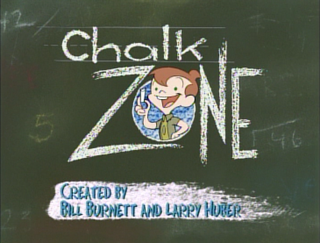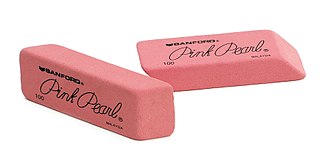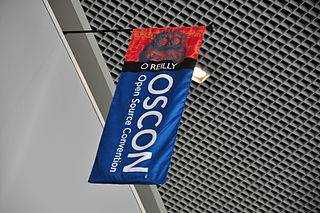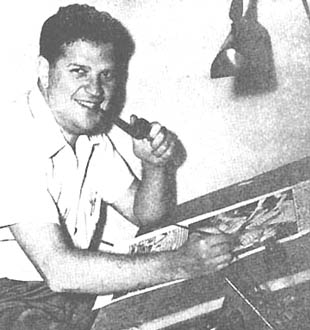
A pencil is a writing or drawing implement with a solid pigment core in a protective casing that reduces the risk of core breakage, and keeps it from marking the user's hand.

A blackboard or a chalkboard is a reusable writing surface on which text or drawings are made with sticks of calcium sulphate or calcium carbonate, known, when used for this purpose, as chalk. Blackboards were originally made of smooth, thin sheets of black or dark grey slate stone.

ChalkZone is an American animated television series created by Bill Burnett and Larry Huber for Nickelodeon. The series follows Rudy Tabootie, an elementary school student who discovers a box of magic chalk that allows him to draw portals into the ChalkZone, an alternate dimension where everything ever drawn on a blackboard and erased turns to life. Rudy is joined in his adventures by Snap, a wisecracking superhero Rudy once drew with chalk, and Penny Sanchez, Rudy's academically intellectual classmate and personal friend.

A whiteboard is a glossy, usually white surface for making non-permanent markings. Whiteboards are analogous to blackboards, but with a smoother surface allowing for rapid marking and erasing of markings on their surface. The popularity of whiteboards increased rapidly in the mid-1990s and they have become a fixture in many offices, meeting rooms, school classrooms, public events and other work environments.

A marker pen, fine liner, marking pen, felt-tip pen, felt pen, flowmarker, sign pen, vivid, texta, sketch pen or koki is a pen which has its own ink source and a tip made of porous, pressed fibers such as felt. A marker pen consists of a container and a core of an absorbent material that holds the ink. The upper part of the marker contains the nib that was made in earlier times of a hard felt material, and a cap to prevent the marker from drying out.

An eraser is an article of stationery that is used for removing marks from paper or skin. Erasers have a rubbery consistency and come in a variety of shapes, sizes, and colors. Some pencils have an eraser on one end. Less expensive erasers are made from synthetic rubber and synthetic soy-based gum, but more expensive or specialized erasers are made from vinyl, plastic, or gum-like materials.

A highlighter, also called a fluorescent pen is a type of writing device used to mark attention to sections of text by marking them with a vivid, translucent colour. A typical highlighter is fluorescent yellow, with the color coming from pyranine. Different compounds, such as rhodamines are used for other colours.

The O'Reilly Open Source Convention (OSCON) was an American annual convention for the discussion of free and open-source software. It was organized by publisher O'Reilly Media and was held each summer, mostly in Portland, Oregon, from 1999 to 2019.
A writing implement or writing instrument is an object used to produce writing. Writing consists of different figures, lines, and or forms. Most of these items can be also used for other functions such as painting, drawing and technical drawing, but writing instruments generally have the ordinary requirement to create a smooth, controllable line.

Jack Kamen was an American illustrator for books, magazines, comic books and advertising, known for his work illustrating crime, horror, humour, suspense and science fiction stories for EC Comics, for his work in advertising, and for the onscreen artwork he contributed to the 1982 horror anthology film Creepshow.
In quantum mechanics, a quantum eraser experiment is an interferometer experiment that demonstrates several fundamental aspects of quantum mechanics, including quantum entanglement and complementarity. The quantum eraser experiment is a variation of Thomas Young's classic double-slit experiment. It establishes that when action is taken to determine which of 2 slits a photon has passed through, the photon cannot interfere with itself. When a stream of photons is marked in this way, then the interference fringes characteristic of the Young experiment will not be seen. The experiment also creates situations in which a photon that has been "marked" to reveal through which slit it has passed can later be "unmarked." A photon that has been "unmarked" will interfere with itself and once again produce the fringes characteristic of Young's experiment.
A delayed-choice quantum eraser experiment, first performed by Yoon-Ho Kim, R. Yu, S. P. Kulik, Y. H. Shih and Marlan O. Scully, and reported in early 1998, is an elaboration on the quantum eraser experiment that incorporates concepts considered in John Archibald Wheeler's delayed-choice experiment. The experiment was designed to investigate peculiar consequences of the well-known double-slit experiment in quantum mechanics, as well as the consequences of quantum entanglement.

An ink eraser is an instrument used to scrape away or chemically bleach ink from a writing surface. This is a more involved process than removing pencil markings. Pencil marks can be gradually adhered to natural rubber fragments by rubbing the mark with a pencil eraser Ink, however readily penetrates the fibers of most papers and is therefore more difficult to extract by mechanical action.
Wet-wipe markers or wet-erase markers are a type of writing implement, which are used primarily on overhead transparencies, tablets at restaurants, and office calendars. Other uses include writing on mirrors, chalkboards, plastics, ceramics, glass windows and other non-porous surfaces. The contents of these markers are water, resin, and titanium dioxide.

Asphalt roll roofing or membrane is a roofing material commonly used for buildings that feature a low sloped roof pitch in North America. The material is based on the same materials used in asphalt shingles; an organic felt or fiberglass mat, saturated with asphalt, and faced with granular stone aggregate. The installation process, known as Torch On Roofing, is often used on commercial properties in North America.
Gary Simmons is an American artist from New York City. Using icons and stereotypes of American popular culture, he creates works that address personal and collective experiences of race and class. He is best known for his "erasure drawings," in which he draws in white chalk on slate-painted panels or walls, then smudges them with his hands – a technique that renders their imagery ghostly.

Carbon dust is an artistic technique in which carbon dust is applied to a surface via dry brushes. Highlights may be painted on or scratched out later in the process. Dust is prepared by rubbing carbon pencils against an abrasive surface, such as a metal file. The technique was popularized by Max Brödel (1870-1941) and became widely used among medical and scientific illustrators in the twentieth century.

Artists' charcoal is charcoal used as a dry art medium. Both compressed charcoal and charcoal sticks are used. The marks it leaves behind on paper are much less permanent that with other media such as graphite, and so lines can easily be erased and blended. Charcoal can produce lines that are very light or intensely black. The dry medium can be applied to almost any surface from smooth to very coarse. Fixatives are used with charcoal drawings to solidify the position to prevent erasing or rubbing off of charcoal dusts.
Do Not Erase: Mathematicians and their Chalkboards is a photo-essay book on the blackboards of mathematicians. It was photographed and edited by Jessica Wynne, and published in 2021 by the Princeton University Press.













